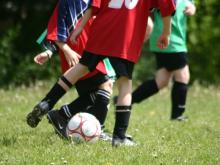Participation in youth sports leagues may not provide enough exercise for children, according to a study of 200 youth aged 7-14 years published in the April issue of Archives of Pediatric & Adolescent Medicine.
According to the Centers for Disease Control and Prevention, adolescents should participate in 60 minutes of moderate-to-vigorous physical activity (MVPA) daily. However, the cross-sectional study showed that only 24% of participants met the 60-minute physical activity guideline during practice, said Ms. Desiree Leek of the San Diego State University and her associates.
Participants from two moderate-income cities in California were recruited from 29 teams and included 103 soccer players and 97 baseball or softball players. They were separated into age groups of 7- to 10-year-olds (125 players) and 11- to 14-year-olds (75 players). Players each received a small prize worth $2 compensation for participating (Arch. Pediatr. Adolesc. Med. 2011;165:294-9).
Participants wore an ActiGraph accelerometer during practices to record their metabolic equivalents. The response rate was 93% for soccer players and was not collected for soccer and baseball players.
Study results showed a difference in MVPA based on sport, age, and sex. According to results, only 2% of softball players met the 60-minute mark, as soccer players averaged 10.6% (13.7 minutes) more time in MVPA. Fewer than 10% of 11- to 14-year olds met the guideline, with 7- to 10-year-olds averaging 5.8% (7 minutes) more time in MVPA. Only 2% of girls met the guidelines, with boys averaging 7.8% (10.7 minutes) more time in MVPA. Overall, girls spent 11 minutes less being active during practices than did boys.
According to Dr. James Sallis, one of the study’s main researchers, these results highlight a national trend and the importance of community action.
"Physicians and parents should not assume that just because a child is enrolled in sports, they are active enough," Dr. Sallis said in an interview. "In the midst of the childhood obesity epidemic, we need sports, dance lessons, PE classes, and after-school programs to do their part to get kids active every day."
Dr. Sallis said physicians should encourage parents to put pedometers on their children to see how much exercise they are getting, recommending 10,000-15,000 steps daily.
Study weaknesses included recruitment from one geographic region, limited responses on the demographic survey, and the nonrandomized, cross-sectional design. In addition, the study assessed only community leagues that required payment.
The study was supported by a National Institutes of Health Summer Research Grant through the University of California, San Diego. Ms. Desiree Leek and her associates reported no relevant financial disclosures.


